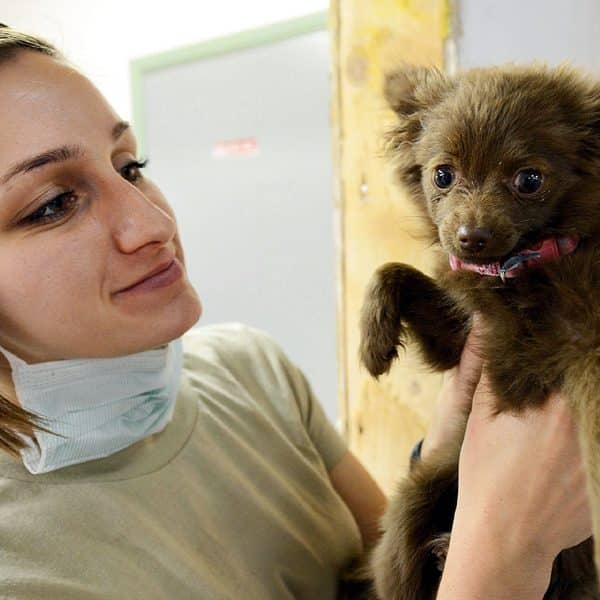I’m horribly allergic to cats, so of course, almost all of my friends have them. Often, they — my friends, that is, not their cats — will offer me an antihistamine, like Benadryl, from their medicine cabinet to alleviate my suffering. Our dogs experience allergies differently than we do. Rather than sneezing, they tend to express allergic reactions through persistent itchy skin. Excessive scratching can cause dogs to develop sores, exposing them to needless infection. Is Benadryl safe for dogs? Can it help with other minor canine health issues?
What is Benadryl?
Giving dogs Benadryl, like any human medication, can be a dicey proposition. While it is among the most commonly prescribed over-the-counter medicines that veterinarians recommend for dogs, it is not without its risks. The active ingredient in regular-strength Benadryl is diphenhydramine. Note the modifier, “regular-strength,” since, as we know, there are always a range of additional ingredients in common meds that help with a range of other human ailments. Even normal Benadryl can have unexpected benefits for dogs, and is used to treat a number of issues. These include:
- Environmental allergies
- Insect stings and parasite bites
- Anxiety
- Motion sickness

Benadryl can be safe for dogs in consultation with a vet. (Photo via Pixabay)
According to PetMD’s Jessica Vogelsang, DVM, diphenhydramine has a “wide safety margin” where dogs are concerned. Let’s look at dog health conditions that Benadryl may help with and ways it can be administered after consulting with your vet.
Benadryl for dog allergies
When you hear “environmental allergies,” you may think of pollen, dust, or mold, things typically found in both our indoor and outdoor environs that trigger allergic reactions. We express these through sneezing, watery eyes, and other responses we associate with our respiratory system. Dogs can react to the same stimuli, but in radically different ways. Atopic dermatitis is their most frequent allergic reaction, and involves scratching that starts at the head before encompassing the whole body. Depending on the severity of a dog’s allergies, cortisone is far more effective than Benadryl. Benadryl isn’t the only form of diphenhydramine, though, and your vet can recommend better ones for these sorts of allergic reactions.
Dog allergies also include adverse reactions to bites and stings. An upset bee or wasp, or a particularly vicious flea bite on your dog’s body can provoke similar scratching. Treating these kinds of dog allergies with Benadryl is a far more reliable use of the drug. The dog’s skin may reveal more in these cases than their responses to environmental allergies. You may notice swelling in particular, along with a rising skin temperature.
Benadryl for anxious dogs
Dogs experience and express anxiety in any number of scenarios, from separation anxiety to adversely reacting to meeting new people and dogs. Whether it’s protracted noises from construction, thunderstorms, or fireworks displays, or the restriction of movement that comes with being put in a crate or kennel when guests arrive, some dogs have extreme reactions to anxiety.

Benadryl for dogs can alleviate reactions to stings or bites. (Photo by H. Michael Karshis on Flickr)
One of Benadryl’s more interesting, as well as risky, off-label uses is as a very mild sedative in dogs. Certain drugs that are capable of quickly moving from the blood into the brain, like Benadryl’s active ingredient diphenhydramine, have calming, even mildly sedative properties. Because it can pass into the brain so rapidly, usually taking effect within 30 minutes after ingestion, Benadryl’s fast-acting nature might be useful to treat occasional and anticipated episodes of anxiousness.
Benadryl for motion sickness
As a sedative, another major off-label usage for Benadryl is for dogs who can be counted on to experience motion sickness, whether by land, sea, or air, during infrequent travel. When a long trip is planned and the dog is along for the ride, motion sickness can cause some dogs a great deal of stress. Canine reactions can range from restlessness to barking, and from vomiting to defecation.
If thundershirts, music, or restricting a dog’s line of sight have proven ineffective in the past, ask your veterinarian if Benadryl might make your dog sufficiently drowsy to endure a long voyage. Keep in mind that, as with other sedative medications, there may be lingering effects once the trip is concluded. There may be disorientation and continued grogginess, which is one reason any human medication you employ with your dog should be under veterinary supervision and used very rarely.

Diphenhydramine can be recommended for motion sickness in dogs. (Photo by Nisa yeh on Flickr)
Is Benadryl appropriate for hyper dogs?
Diphenhydramine may have a wide safety margin, but it’s worth repeating the scientific name to remind ourselves that it is still a powerful and fast-acting drug that should not be used casually. By that, we mean that it is not recommended if your dog is barking late at night or otherwise bothering you and you just want them to settle down. Yes, Benadryl can make your dog drowsy and sleepy, but it is not intended to be used on a regular basis as a dog tranquilizer. Regular and consistent exercise is a much more effective and drug-free method for soothing an overactive dog.
Benadryl dosage for dogs
Aside from the multiple formulas — regular strength, extra strength, or any other variation which may include additional, less-safe active ingredients — Benadryl is available in a number of formats. From ingestibles, including pills, tablets, gel caps, and liquid varieties, there are also infant and children’s versions, and topical creams that have diphenhydramine as their active ingredient. The type, strength, and formula can all make a difference, and have a distinct impact on a dog. Always consult with your dog’s veterinarian before giving a dog any kind of human medication.
Every piece written by canine health specialists and veterinarians on the internet agrees with a very basic dosage standard for dogs. The most thorough treatment of Benadryl dosage by format that we consulted addresses each format and provides warnings and cautions for each. The rule of thumb for regular-strength Benadryl, where diphenhydramine is the only active ingredient is 1mg per 1lb of body weight. That is only a rule of thumb, not an infallible nor universal guideline. Naturally, a Chihuahua, a Pug, or a Yorkie will need less than a Bulldog or a Great Dane.

Benadryl is often used to treat dog’s environmental allergies. (Photo via Wikimedia Commons)
Side effects of Benadryl for dogs
Can you give Benadryl to dogs? Yes. Is it safe? By and large, yes. It is important to remember that this family of human over-the-counter medications, while frequently recommended by vets, is not FDA-approved as a medicine for dogs, per se. Sleepiness is one side effect you know of; it may surprise you to learn that another is excitability and an increased heart rate.
Other side effects for dogs include increased drooling, panting, and depression. They are rare, but there have also been reported and documented instances of dogs who have fatally overdosed on diphenhydramine, especially when its ingested with other chemicals. Take care of your dogs, and always seek veterinary advice before administering any OTC product to them!
The post Is Benadryl Safe for Dogs? appeared first on Dogster.
No comments:
Post a Comment